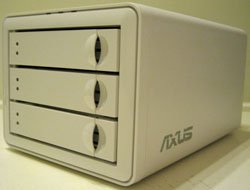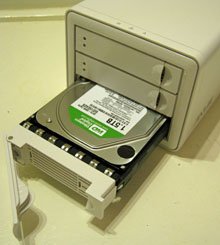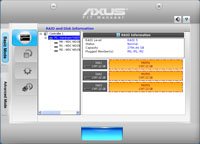From time to time DigitalReviews is approached to review products because of our reputation for unbiased, no holds barred reviews. I have to admit that I never heard of Axus in my travels, but they have kindly provided two of their FiT RAID Series chassis for our reviewing pleasure. Axus is a Taiwanese company that appears to specialise in storage – large amounts of it at 16 or 24 bays with fibre channel or SCSI interfaces. The Fit Series is their new foray into the lower end of the market and we will be reviewing the FiT 300E and the FiT 500E.
So how do these stack up?
 First Impressions
First Impressions
The FiT chassis are quite compact for what they are. The FiT 300E comes in all white livery and even when unpopulated with disks is surprisingly heavy. The weight is testimony to a solid construction with a full metal cage fabricated from the same type of material as the frame of a good PC casing. Each tray is solidly metal with plastic rail guides and a levered handle to lock the drive in place. The FiT 300 is marginally higher and wider than a 3.5″ HDD and about 1/3 deeper. Clever design has the cooling fan as a module which clips onto the main chassis with a connector to the backplane. Gracing the back of the unit is a USB port (Type B), an eSATA port, power button, DC in, a Kensington lock port and a Set/Mute/Backup button. Lastly on the back is a rotary switch which can pre-configure the mode of the disks such as RAID0,1,3 or 5 and GUI configuration amongst other settings. Three discreet LEDs on top of the front panel provide indications to the status of the chassis and each drive tray has its own LEDs.
The FiT 500 comes in all black matt livery and aside from being taller to cater for 5 drives, it has an extra slot for a controller with an LCD panel.
 Configuration
Configuration
To create the RAID volume you can set the rotary switch to the RAID mode desired, hold the “Set/Mute/Backup” button whilst powering on the FiT then release the button 5 seconds after the FiT powers on. Alternatively set the rotary switch to GUI and configure via the FiT Manager. The rotary switch can be set to any of the following options:
* GUI – Create RAID volumes by FiT Manager
* R5 – Create a RAID5 volume (requiring minimum 3 disks)
* Large – Create a big volume without RAID feature
* PM – Delete RAID volume
* R0 – Create a RAID 0 volume (requiring minimum 2 disks)
* R1/R0 – Create a RAID1/R10 volume (requiring minimum of 2 or 4 disks)
* Clone – Create a clone volume and all hard disks backs up each other
* R3 – Create a RAID3 volume (requiring minimum 3 disks)
With 3 Western Digital Caviar Green (WD15EADS) 1.5Tb SATA drives in the FiT 300E, the RAID took no time to initialise and be ready for use. According to the event logs, it took approximately 2 minutes 59 seconds from drive detection to the RAID set being ready. Although the WD drives were not on the official compatibility list, they are more power efficient than the equivalent Seagate and I opt to try them out with Axus’ full knowledge. With a RAID5 configuration, I was left with 2.72 Tb of space to use.
 In Action
In Action
Once the configuration is done, there is not much to do but to connect the FiT to a computer via either USB or eSATA. With the very delicate state of disintegration of my server hardware, I opt to use the USB connection over opening up the machine to hook up the eSATA ports. Lately with every restart of that machine it feels like it might be the last.
On a variety of Microsoft Operating Systems, ranging from Windows XP, Windows 7 and 2003 Server, there were no issues with detecting the USB RAID5 device. Drivers were installed automatically and that large hard drive size was not an issue (GPT disks have some limitations requiring minimum OS standards).
Without much fanfare, I started transferring data from a particularly troublesome disk from my system onto the FiT 300. Transfer rates from a slightly temperamental IDE (yes they still exist!) hard disk is hardly a fair test on any device. Data copy from a internal SATA device that is healthy to the FiT gave some indication of the real transfer rates possible.
For a timed test I ran some large file transfers from another USB connected device and had the following statistics from Robocopy. In two different tests I managed to transfer 44 files with a total size of 15 Gb in 21 minutes 54 seconds, an average of 703.5 Mb/min (11.72 Mb/sec) The second test was of 111 files totalling 54 Gb that completed in 75 minutes 29 seconds, an average of 734 Mb/min (12.23 Mb/sec).
Lastly I performed a transfer from my notebook’s internal DVD drive, 2494 files with a total size of 4.4 Gb in 21 mins 39 seconds, an average of 208 Mb/min (3.5 Mb/sec).
Other Features
The FiT Manager GUI is pretty simple beyond the basic configuration. There is set up for one button backup which calls on an external program and allows you to pass arguments to the command line. This is initiated when the backup button on the back of the chassis is pressed.
There is event notification capability via SMTP with pre-defined events ranging from informational to warnings and failures. To minimise power usage in a greening world, the RAID can be set to put disks in standby mode from 0 to 10922 minutes if there is no activities.
Box Contents
 FiT 300 RAID subsystem
FiT 300 RAID subsystem
3 x HDD trays
1 x Fan module
1 x 90W power adapter
1 x SATA to SATA cable
1 x 1394a to 1394b cable
1 x 1394b to 1394b cable
User Manual and software CD
Quick Installation Guide
FiT 500 RAID subsystem
5 x HDD trays
1 x Fan module
1 x SATA to SATA cable
1 x 1394a to 1394b cable
1 x 1394b to 1394b cable
User Manual and software CD
Quick Installation Guide
Specifications
FiT 300
Number of bays: 3
Mounting: Tower
RAID level: 0/1/3/5/PM/Large/Clone
Event notification: Buzzer, GUI
Disk interface: Sata I/II
HDD size: 3.5″
RAW capacity: up to 4.5 Tb
RAID management: GUI / Rotary switch (Windows /Linux / Mac OS (OS independent and transparent)
Power supply: 90W (adapter), DC output 19V, 4.74A Max
Electrical: AC Voltage 100~240 VAC / AC frequency 50~60 Hz
Temperature: Operating temperature 5 to 35C, Non-operating temperature : -40 to 60C
Relative humidity: 20% – 80% non-condensing
Dimension: 140x237x115 mm (WxDxH)
Weight: 2.03 kg
FiT 500
Number of bays: 5
Mounting: Tower
RAID level: 0/1/3/5/PM/Large/Clone
Event notification: Buzzer, GUI
Disk interface: Sata I/II
HDD size: 3.5″
RAW capacity: up to 7.5 Tb
RAID management: GUI / LCD / Rotary switch (Windows /Linux / Mac OS (OS independent and transparent)
Power supply: 200W
Electrical: AC Voltage 100~240 VAC / AC frequency 50~60 Hz
Temperature: Operating temperature 5 to 35C, Non-operating temperature : -40 to 60C
Relative humidity: 20% – 80% non-condensing
Dimension: 140x242x208 mm (WxDxH)
Weight: 3.88 kg
 Gripes
Gripes
Usually when it comes to this part of the review, I already have identified a number of issues with a device. In the case of the Axus FiT series I was left scratching my head a little. Honestly I do not have any real issues with the Axus. It is a simple device to configure and operate. On initial start up the fan can be quite noisy but that dies down in under a minute.
Secondly the provided CD with the software does not autorun as indicated in the manual. There was a small amount of guess work as to which executable to run but that hardly rates as a gripe.
The backup button is located at the back of the chassis and is hard to find by feel.
I would have preferred it to be more prominent but not necessarily moved to the front.
Conclusions
The Axus FiT series is a pretty stylish hardware RAID storage device, there is no doubt that it was a breeze to use with good sustained performance. In my tests with both small and large files it managed more than decent sustained transfer rates via USB. No doubt with eSATA this would be even better given Axus’ own specifications rates RAID5 performance at over 220 MB/sec for both read and write. A Firewire version is also under development.
For most people the complexity of many networked storage solutions can be daunting and a much simpler setup such as this RAID system from Axus can be a much better proposition.
The Axus FiT300 has a SRP of USD$259 and the FiT500 is at USD$459 without disks. A list of global stockists is available here.
Our Rating?
Given that both these RAID systems from Axus have a great design, are easy to install and use and have great value for money, the team here at DigitalReviews Network have decided to give both the Fit300 and Fit500 our coveted Editor’s Choice Award.
A highly recommended 9 out of 10!



